As gentle as you have lived,
have you died,
too holy for sorrow!
Let no eye shed a tear
for the spirit’s heavenly homecoming.
The words of Friedrich Haug, commemorating the death of the philosopher-poet Johann Georg Jacobi in 1814 and set that year by Ludwig van Beethoven in his ‘Elegaic Song’, express the gospel sentiments which this final Live from London programme encapsulated: ‘The light shines in the darkness, and the darkness has not overcome it.’ (John 1:5)
Light from Darkness, in which VOCES8 were joined in the VOCES8 Centre at St Anne and St Agnes by the English Chamber Orchestra and conductor-pianist James Sherlock, was a musical journey of remembrance, reflection and renewal. It was framed by Beethoven, beginning with the Elegischer Gesang Op.118. Originally for string quartet and choir, the work was composed for Baron Johann Pasqualati in whose house Beethoven intermittently resided between 1804 and 1815, and who became a close friend. The Song was first performed at a private ceremony to commemorate the third anniversary of the death of the Baron’s wife.
The opening string introduction was introspective but imbued with mezza voce warmth, reminiscent of the slow, unfolding beauty of one of Beethoven’s string quartet Adagio movements. But, the entry of the voices brought drama and contrast, as reverence was interrupted by sorrow: “zu heilig für den Schmerz!” The imitative imploring, “Kein Auge wein’ ob” (let no eye shed a tear), seemed challenged by the voices’ weeping chromatic, but heavenly light blazed as the major key asserted itself, “des himmlischen Geistes Heimkeh” and henceforth the strings’ spirit seemed lifted, the voices’ closing prayer one of heartfelt peace.
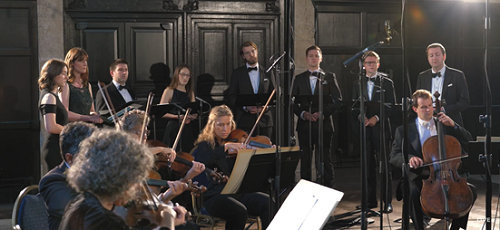
The central part of the concert comprised both instrumental and vocal items. Brahms’s motet Geistliches Lied Op.30 is scored for double choir and either organ or piano for three/hour hands. Here, the organ was evoked by divisi strings, with bass, celli and violas prominent, conjuring the sonorities of the Deutsches Requiem. From the deep, noble lines wound upwards, yearning yet elegant, as Sherlock shaped the vocal lines into a soft, sumptuous unity, redolent with an almost Brucknerian expanse and serenity.
Mozart’s Ave Verum Corpus K618 is a simple communion motet, composed for Anton Stoll, the choirmaster at Baden which, in 1791, the composer’s wife Constanze visited for medical treatment. It is one of the composer’s best known and best loved works, and here it received a due simplicity and directness. It’s a work that cannot bear much mannerism, and a well-shaped diminuendo which allowed the final plea, “esto nobis praegustatum in mortis examine”, to burst from the shadows was well-judged, the expression economical but telling.
Mozart also provided Sherlock with the opportunity to perform as soloist, leading, in partnership with violinist Stephanie Gonley, from the keyboard of the Blüthner Model 1 piano which he inherited from Graeme Mitchison – a Cambridge don, described by Sherlock as one ‘whose academic prowess in pure mathematics, biology and quantum mechanics belied a virtuoso piano technique and an all-encompassing love of music’ – and which currently resides in The VOCES8 Centre.
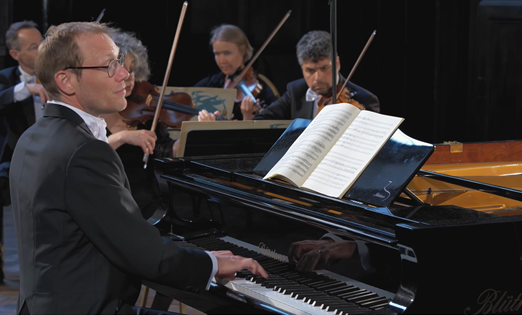
Mozart’s Piano Concerto No.12 in A K414 was composed in 1782 as one of a set of three concertos designed to introduce Mozart to Vienna. Only the fifth piano concerto that Mozart composed, it is fairly modest in scope and forces, but cheerful and fresh. In December 1782 Mozart wrote to his father, ‘These concertos are a happy medium between too heavy and too light. They are very brilliant, pleasing to the ear, and natural, without being insipid. There are parts here and there from which connoisseurs alone can derive satisfaction, but these passages are written in such a way that the less learned cannot fail to be pleased, albeit without knowing why.’ Indeed, Dvorak’s remark, made during a lecture at the Prague Conservatoire, seems to describe this Concerto perfectly: “Mozart is sweet sunshine!”
This performance distilled the essence of Mozartian grace. The phrasing was elegant, the timbre clean but warm, and ornaments idiomatic but also personalised at times, particularly in the Andante where the piano’s elaborations extended the melodic lines in an improvisatory vein. Both orchestra and soloist pointed the nuances: dynamic juxtapositions were tautly executed, cadential double-stops were stylish, rhythmic motifs and syncopations were springy, and there was spaciousness where it was required. In the rare modulations to the minor tonality, the opportunity for drama was seized, as at the close of the development section of the first movement where the skies momentarily darkened only to be nonchalantly shrugged off by Sherlock’s running flourish, as if escaping from the fermata. When the three concertos were published as a set, Mozart provided two alternative sets of cadenzas. Sherlock chose the first set, making virtuosity serve the music’s expressiveness; the voicing the second of the Andante’s cadenzas was particularly impressive.
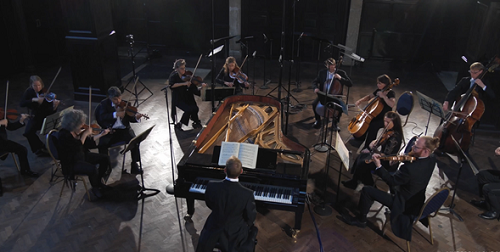
Sherlock did not play with the tuttis – as we know that Mozart would have done – but he epitomised the Enlightenment spirit; all was crystalline, light and aristocratic, but not without moments of flowing lyricism and profound insight. The piano solo spoke with patrician assurance when it roved independently. The oboes and horns were absent, but the fuller string texture was satisfying compensation. Only in the Andante did we miss the swelling colours of the wind, though the rich vibrato in the string tuttis was welcome, retreating judiciously when accompanying the piano.
Samuel Coleridge-Taylor’s Four Novelletten Op.52 seemed at first glance an unusual choice for the programme. Composed in 1902, and score for strings, tambourine and triangle, the Novelletten may draw their title from Robert Schumann’s Op.21 piano miniatures of 1838; they are certainly ‘romantic’ in all senses of the word, but their indulgent sentimentality is balanced by interesting explorations of string timbres and textures. The third Novellette, ‘Waltz’, draws its material from Coleridge-Taylor’s Op.8 Symphony. Minus its percussive sparkle here, the dance eschewed schmaltz for true feeling, inspired not least by Stephanie Gonley’s soaring, shining solo, and by the confident richness of the contrasting duple-time passages, which leaned forwards and reached upwards, spinning with vigour and brightness.
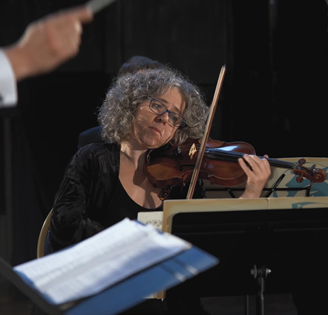
Paul Sherman’s double bass was a stern, dark anchor in Frank Bridge’s Lament, upon which divisi strings settled and meandered, and from which the solo cello, viola and violin arose in contemplative song. The work’s full title is ‘Lament (Catherine, aged 9, ‘Lusitania’ 1915)’: it was designed as a memorial for a tenderly young victim, whom Bridge knew personally, of the sinking of the Lusitania, and apparently composed in a single day (14th June 1915). The reflective intensity achieved was surely assisted by the close seating of the strings, the players sharing desks, so that a truly unified sound was possible. The music’s beauty was shadowed by dolefulness, but the melodies were never maudlin.
Beethoven’s Choral Fantasy Op 80 is one of the composer’s strangest works. Composed as a festive conclusion to a four-hour benefit concert at the Theater an der Wien on 22nd December 1808, the Fantasy opens with a piano solo (extemporized by Beethoven at the first performance), is followed by several variations for piano and full symphony orchestra on a simple song melody that he had written in the 1790s, and ends with a short choral conclusion which seems like a trial run for the ‘Ode to Joy’. At the first performance, things fell apart and the Fantasy had to be restarted; the solo soprano was sung, inadequately, by a replacement singer for the original soprano with whom Beethoven had quarrelled. It was also freezing cold in the theatre. The evening was not a success. Given, the work’s innate eccentricity it wasn’t perhaps such an outrageous decision to elect to close this Live from London series with the ‘Finale’ of the work as performed by a pianist and eight singers?
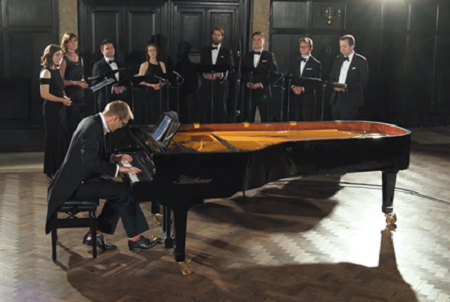
In fact, what was billed as the ‘Finale’ turned out to be the opening Adagio for solo piano – Sherlock gave the Blüthner quite a workout! – and the concluding choral section which begins Allegretto, ma non troppo and accelerates with an almost crazy, wilful energy to a fortimisso, Presto exultation, “Nehmt denn hin, ihr schönen Seelen, froh die Gaben schöner” (Accept then, you beautiful souls, Joyously the gifts of high art), celebrating the bestowal of divine grace on humankind. The balance between voices and piano was surprisingly good – the VOCES8 behind-the-camera team once again did a sterling job – and the high vocal lines didn’t trouble the singers. But, surely a bit more wildness and euphoria was called for? For once VOCES8 seemed far too serene, as musical madness broke loose!
It was, though, an uplifting end to the concert, and to the Summer 2021 series. There is more to come, we were told by Paul and Barnaby Smith during the familiar pre-concert ‘chat’. There will be a Christmas Festival – look out for an announcement in the autumn – and in the coming months, live concerts will take place alongside digital events, with VOCES8 planning to open up the library of LFL concerts that have gone before. And, there will be a chance to vote for your five favourite LFL concerts, to be streamed as a set, on demand. I don’t think I’ll be able to choose.
Claire Seymour
Light from Darkness: English Chamber Orchestra, James Sherlock (piano & conductor), VOCES8
Beethoven – Elegischer Gesang Op.118, Mozart – Piano Concerto No.12 in A K414, Ave Verum Corpus K618, Coleridge-Taylor – Novelletten Op.52, No.3 (‘Valse’), Bridge – Lament H.117, Brahms – Geistliches Lied Op.30, Beethoven – Finale from the Choral Fantasy Op.80.
St Anne and St Agnes, VOCES8 Centre, City of London; Sunday 22nd August 2021.